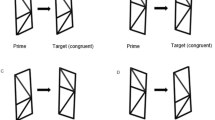Abstract
Visually guided prehension is controlled by a specialized visuomotor system in the posterior parietal cortex. It is not clear how this system responds to visual stimuli that lack three-dimensional (3D) structure, such as two-dimensional (2D) images of objects. We asked a neurological patient with visual-form agnosia (patient D.F.) to grasp 3D objects and 2D images of the same objects and to estimate their sizes manually. D.F.’s grip aperture was scaled to the sizes of the 2D and 3D target stimuli, but her manual estimates were poorly correlated with object size. Control participants demonstrated appropriate size-scaling in both the grasping and manual size-estimation tasks, but tended to use a smaller peak aperture when reaching to grasp 2D images. We conclude that: (1) the dorsal stream grasping system does not discriminate in a fundamental way between 2D and 3D objects, and (2) neurologically normal participants might adopt a different visuomotor strategy for target objects that are recognized to be ungraspable. These findings are consistent with the view that the dorsal grasping system accesses a pragmatic, spatial representation of the target object, whereas the ventral system accesses a more comprehensive, volumetric description of the object.
Similar content being viewed by others
Author information
Authors and Affiliations
Corresponding author
Rights and permissions
About this article
Cite this article
Westwood, D.A., Danckert, J., Servos, P. et al. Grasping two-dimensional images and three-dimensional objects in visual-form agnosia. Exp Brain Res 144, 262–267 (2002). https://doi.org/10.1007/s00221-002-1068-y
Received:
Accepted:
Published:
Issue Date:
DOI: https://doi.org/10.1007/s00221-002-1068-y




